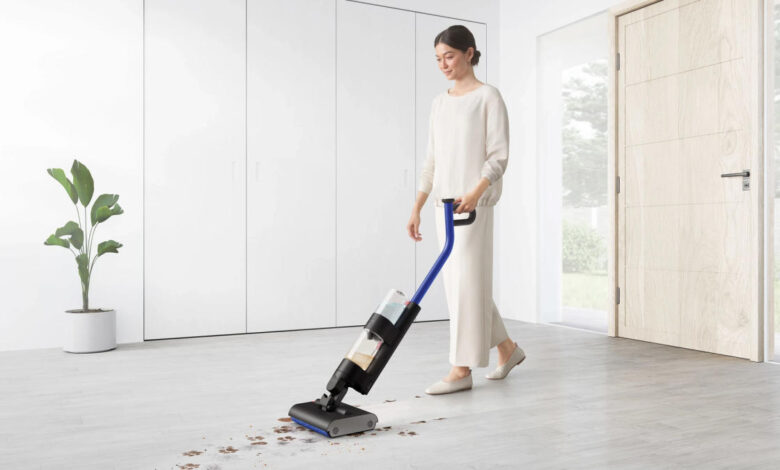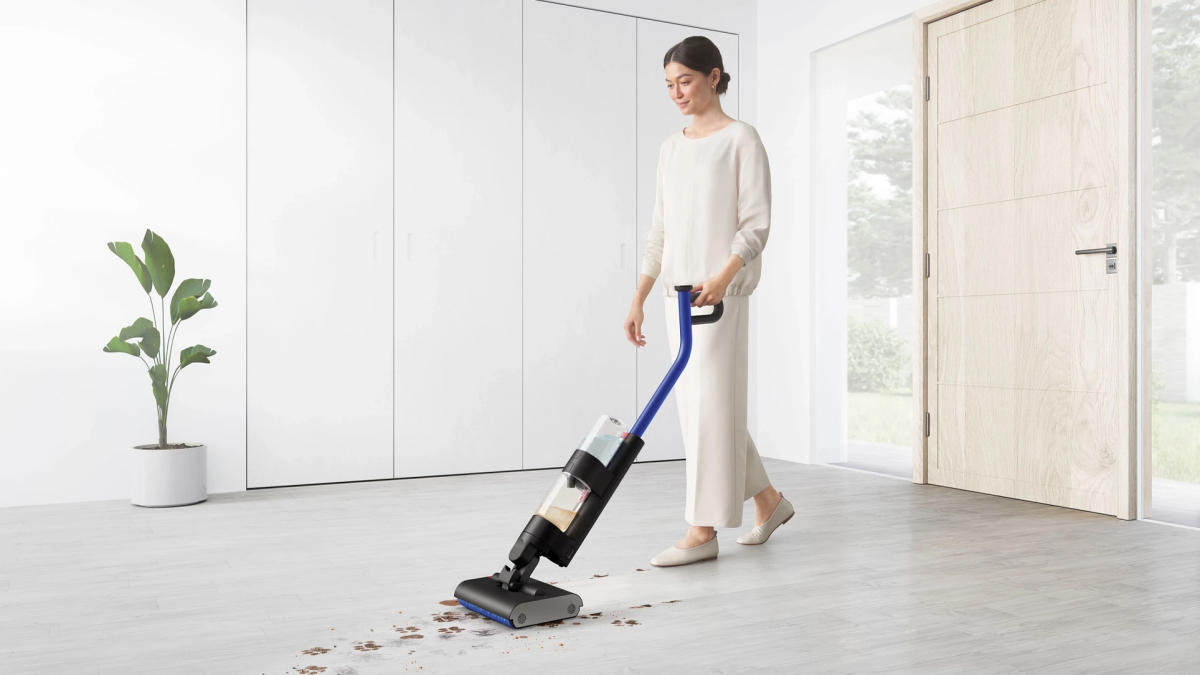Dyson’s first dedicated hard floor cleaner doesn’t suck


It’s a new direction for Dyson: a floor cleaner without mention of suction, cyclone technology or any of its usual vacuum vocabulary. The Wash G1 is the company’s debut hard-floor cleaner, and it swaps suction for high-speed rollers, water and nylon bristles. It’ll go on sale later this year for $700/ £600, which is expensive but still cheaper than Dyson’s top-of-the-line Gen 5 vacuum. I got to test out the Wash G1 at Dyson’s HQ, a few hours west of London in the UK.
The product was born from the increased presence of hard floors in our lives. Dyson says there are fewer and fewer carpeted rooms in homes around the world. However, hard-floor cleaning (industrial processes aside) has remained a pretty manual process, usually involving mops (or Swiffer cloths, you monster) that leave smears and streaks. Typical mopping also leads to wiping diluted dirt and stains around your floors after the first dunk.
Dyson’s method keeps the fresh and dirty water separate as you clean, with dual microfiber rollers that apply the water, mechanically removing stains and dirt. The company dabbled with this on its V15 Detect Submarine, which had a dedicated cleaning head with (much smaller) water compartments built in. The Wash G1 pulls dirty liquid up into its own container, capturing any physical debris into a slim tray with a mesh filter.
The rollers rotate in opposite directions, which helps lift stains and dirt. While testing it, the rollers also gave the cleaner a floaty sensation as I swished it around. The high-density microfiber cloths then absorb and trap both liquids and solid dirt, while hardened nylon bristles pull away bigger dirt and objects into a tray. The dirty water is also squeezed out of the rollers and pulled upwards into the machine.
The Wash G1 has 26 hydration points to “precisely” soak the microfiber rollers, ensuring they’re hydrated enough to tackle stains and dried dirt. The company claims there’s enough water in a single tank to clean the surface area equivalent to a tennis court – but that will depend on the machine’s settings.
There are three hydration levels, while an additional max setting drains the tank much faster, applying as much water as possible for the most stubborn stains. This doesn’t notably affect battery power, as the maximum setting would on a vacuum, because the Wash G1 isn’t pushing the engines harder – it’s just using more water. To reach floor edges, Dyson shifted the roller’s engines to one side so the right side can closely brush up against walls and edges.
The Wash G1 can even perform a self-clean, using half of the clean water tank to flush out the system and clean the brushes. There’s no heating feature, but the rotation should wring out most of the water. This is all done while the Wash G1 is docked and charging, which, instead of the typical cable or rack that Dyson’s other vacuums use, is a flat surface that plugs into the wall.
After using up the clean water tank, it was straightforward to remove and refill – much easier than a coffee machine. The unit with both containers clicks out of the body so you can tip away the dirty stuff and refill it with clean water. The container for the filthy water has a wide mouth, so it’s easy to clean without touching the accumulated dirt.
One issue though: The dirty water tank is… gross. I understand the satisfaction of seeing the dirt and muck as you clean your floors, but a container of cloudy beige mystery is, in person, rather icky. Perhaps Dyson could make it out of a smoky plastic that obfuscates the dirty water, at least a little?
The way Dyson separates out liquid and solid mess also reduces the amount of sludgy muck you’ll get from cleaning floors with water (not to brag, but I may have cleaned a carpet or two in my life). It does this by ensuring that solids aren’t in the water for too long. Dirty water is pulled into its removable container through a pressure differential, meaning there’s also no chance for the dirt to meddle with motors, filters and other delicate parts.
A final microfiber roller then takes up any residual water, and Dyson says it buffs the floor to avoid a streaky finish. During my brief time with the Wash G1, it was still leaving a streaky finish, but maybe Dyson will fix this. After all, there’s plenty of time before this ships to consumers. In the UK, the company is aiming for a fall (well, Autumn) launch, with the Wash G1 coming to the US later this year. The demo space was also a reflective marble surface – arguably a more challenging surface to clean perfectly. My hardwood floors at home probably wouldn’t have shown streaks.
This is Dyson’s first attempt at dedicated hard floor cleaning, and I still have a lot of questions about how well the filtration tray works. How much can you cram into such a slender little thing? We hope to get more answers when we take a closer look ahead of launch later this year.
Source link



